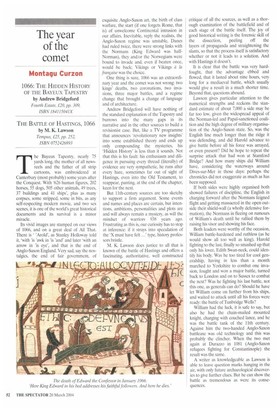The year of the comet
Montagu Curzon
1066: THE HIDDEN HISTORY OF THE BAYEUX TAPESTRY by Andrew Bridgeford Fourth Estate, £20, pp. 309, ISBN 184115041X THE BATTLE OF HASTINGS, 1066 by M. K. Lawson Tempos, £25, pp. 252, ISBN 0752426893 The Bayeux Tapestry, nearly 75 yards long, the mother of all newsreels and the father of all strip cartoons, was embroidered at Canterbury (most probably) some years after the Conquest. With '626 human figures, 202 horses, 55 dogs, 505 other animals, 49 trees, 37 buildings and 41 ships', plus as many corpses, some stripped, some in bits, as any self-respecting modern movie, and two sex scenes, it is one of the world's great historical documents and its survival is a minor miracle.
Its vivid images are stamped on our views of 1066, and on a great deal of All That. There is "Arold', as Stanley Holloway told it, 'with 'is 'awk in 'is 'and' and later 'with an arrow in 'is eye', and that is the end of Anglo-Saxon England. Very sad, say the nostalgics. the end of fair government, of exquisite Anglo-Saxon art, the birth of class warfare, the start (if one forgets Rome, that is) of unwelcome Continental intrusion in our affairs. Inevitable, reply the realists, the Anglo-Saxon regime was unstable, Danes had ruled twice, there were strong links with the Normans (King Edward was halfNorman), they and/or the Norwegians were bound to invade and, even if beaten once, would be back; Vikings or Vikings d la frangaise was the choice. One thing is sure, 1066 was an extraordinary year and the comet was not wrong: two kings' deaths, two coronations, two invasions, three major battles, and a regime change that brought a change of language and of architecture, Andrew Bridgeford will have nothing of the standard explanation of the Tapestry and burrows into the many gaps in its narrative and in the other sources to build a revisionist case. But, like a TV programme that announces 'revolutionary new insights' into some established theory and ends up only compounding the mysteries, his 'Hidden History' is less than it sounds. Not that this is his fault: his enthusiasm and diligence in pursuing every thread (literally) of evidence are very sympathetic, he runs after every hare, sometimes far out of sight of Hastings, even into the Old Testament, to reappear, panting, at the end of the chapter, keen for the next.
But 11th-century sources are too sketchy to support a firm argument. Some events and names and places are certain, but intentions, ambitions, personalities and plots are and will always remain a mystery, as will the mindset of warriors 938 years ago. Frustrating as this is, our curiosity has to stop at inference: if it strays into speculation of the 'X must have felt ...' type, history professors bristle.
M. K. Lawson does justice to all that is known of the battle of Hastings and offers a fascinating, authoritative, well constructed critique of all the sources, as well as a thorough examination of the battlefield and of each stage of the battle itself. The joy of good historical writing is the forensic skill of the dissection, peeling off the layers of propaganda and straightening the slants, so that the process itself is satisfactory whether or not it leads to a solution. And with Hastings it doesn't. It is clear that the battle was very hardfought, that the advantage ebbed and flowed, that it lasted about nine hours, very long for a mediaeval battle, which usually would give a result in a much shorter time. Beyond that, questions abound.
Lawson gives particular attention to the numerical strengths and reckons the standard estimate of about 7,000 a side may be far too low, given the widespread appeal of the Norman-led and Papal-sanctioned coalition and the high degree of military organisation of the Anglo-Saxon state. So, was the English line much longer than the ridge it was defending, and did Harold advance to give battle before all his force was arrayed, or even present? Did he hope to repeat the surprise attack that had won at Stamford Bridge? And how many ships did William have, considering the waterways around Dives-sur-Mer in those days: perhaps the chronicles did not exaggerate as much as has been supposed. If both sides were highly organised both showed failures of discipline, the English in charging forward after the Normans feigned flight and getting massacred in the open outside their shield-wall (a wholly defensive formation), the Normans in fleeing on rumours of William's death until he rallied them by raising his visor and showing his face. Both leaders were worthy of the occasion, William battle-hardened and ruthless (as he would show all too well as king), Harold fighting to the last, finally so smashed up that only his lover, Edith Swan-neck, could identify his body. Was he too tired for cool generalship, having in less than a month marched to Yorkshire to combat one invasion, fought and won a major battle, turned back to London and on to Sussex to combat the next? Was he fighting his last battle, not this one, as generals can do? Should he have let William come on further from his ships, and waited to attack until all his forces were ready: the battle of Tunbridge Wells? William had the luck, it is safe to say, but also he had the chain-mailed mounted knight, charging with couched lance, and he was the battle tank of the 11th century. Against him the two-handed Anglo-Saxon battleaxe was old technology and this was probably the clincher. When the two met again at Durazzo in 1081 (Anglo-Saxon refugees fighting for Constantinople) the result was the same.
A writer as knowledgeable as Lawson is able to leave question marks hanging in the air, with only future archaeological discoveries to give further clues. But he can show the battle as tremendous as were its consequences.


















































































 Previous page
Previous page